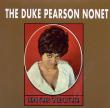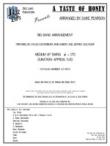SUDEL
Arranged by Duke Pearson, Transcribed by Dylan Canterbury

Cat #: JLP-7331
$35.00This item usually ships within 1 business day.
Questions?
Please call +1-518-587-1102 or email us.
Edition: Jazz Small Group Arrangement
Description: Swing - Medium
Publisher: Jazz Lines Publications
One of the most striking features of Duke Pearson’s writing is its deceptive complexity. When given a small horn section to work with, Pearson frequently found ways to coax as much out of them as possible. This composition is a textbook example of Pearson’s creativeness at its peak. Although the piece only makes use of three horns, the structure and overall sound of Sudel contain an almost big-band-like level of depth.
Mickey Roker’s delightful groove (which has been transcribed for your drummer’s convenience) sets up a disarmingly lovely melody statement by Freddie Hubbard’s trumpet, James Spaulding’s alto, and Joe Henderson’s tenor. The piano doubles this melody statement in the right hand, while playing a completely unique counter-line in the left: a perfect display of Pearson’s inventiveness within the confines of a small group. The switch to a swing groove brings a hint of dissonance before bringing things back to the warmth of the beginning, followed by a brief solo burst from Hubbard. The melody is restated a whole step down from the beginning, followed by a solo moment from Henderson to send the band back to the top for a second run-through. On the original recording, these solo interludes are performed in the following order: trumpet, tenor, alto, trumpet. Chord changes have been included to allow the musicians to change up this order as they see fit.
The piano continues to play the melody riff as accompaniment behind the horn solo. Frankly, it’s too lovely of a melody to completely abandon, and it serves as a very appropriate background. During the piano solo, the horns are to play the figure as a background instead. The melody is repeated after the final solo (with the piano playing the solo fills formerly occupied by the horns) followed by a vamp and fade with a piano solo over the horns riffing the initial four bars of the melody.
In addition to providing a transcription of the original recording, included are alternate trombone and guitar parts to allow for ensemble flexibility. We sincerely hope you enjoy playing this tune as much as we enjoyed preparing it for you!
Alto Saxophone
Tenor Saxophone
Trumpet
Trombone (Optional)
Guitar (Optional)
Piano
Bass
Drums








